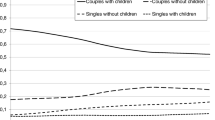Summary
On the basis of a simple general equilibrium model calculations are made of the welfare cost of higher tax rates. Furthermore, the Laffer curve for The Netherlands is estimated. Taking 1970 as the basic year and assuming that all tax revenues were paid back in lump-sum benefits, the Laffer curve topped at a marginal rate of 66.9076 and theMEB stood at 1.24. This means that an additional guilder in tax revenues involves a welfare loss of Dfl. 1.24 on top of the direct tax burden. Considering the true proportion of government income being spent on benefits, the Laffer curve is found at a marginal tax-rate of 70.1016. In that case theMEB amounts to 0.83 in 1970. The most striking finding was the sharp rise in theMEB, from 0.83 in 1970 to 6.36 in 1985. This high welfare cost is an indication that The Netherlands is nearing the limits of taxation on income. It is found that market signals are disturbed most when tax revenues are used for income transfers in a form which does not influence allocation decisions at the margin (lump-sum benefits). In that case relative prices are affected, whereas income effects are neutralized.
Similar content being viewed by others
References
Ballard, C.L., J.B. Shoven and J. Whalley, ‘The Total Welfare Costs of the United States Tax System: A General Equilibrium Approach,’National Tax Journal, 38 (1985), pp. 125–140.
Fullerton, D., ‘On the Possibility of an Inverse Relationship between Tax Rates and Government Revenues,’Journal of Public Economics, 19 (1982), pp. 3–22.
Fullerton, D., J.B. Shoven and J. Whalley, ‘Replacing the U.S. Income Tax with a Progressive Consumption Tax,’Journal of Public Economics, 20 (1982), pp. 3–23.
Hansson, I., ‘Marginal Costs of Public Funds for Different Tax Instruments and Government Expenditures,’Scandinavian Journal of Economics, 86 (1984), pp. 115–130.
Harberger, A.C.,Taxation and Welfare, Boston, 1974.
Keller, W. J.,Tax Incidence: A General Equilibrium Approach, Amsterdam, 1980.
Krapels, F.J. and A. van Ravestein,Gemiddeld en marginaal: de druk van de belastingen en premies sinds 1960, Onderzoeksmemorandum No. 6, Ministry of Economic Affairs, 1987. Ministry of Finance,Miljoenennota 1987, 1986.
Musgrave, R.A. and P.B. Musgrave,Public Finance in Theory and Practice, Tokyo, 1980.
Rosen, H.S.J., ‘The Measurement of Excess Burden with Explicit Utility Functions,’Journal of Political Economy, 86 (1978), pp. 121–135.
SCP, Sociall en Cultureel Plan Bureau,Sociale en culturele verkenningen 1986, SCP-cahier 48, Rijswijk, 1985.
Stuart, C.E., ‘Swedish Tax Rates, Labour Supply and Tax Revenues,’Journal of Political Economy, 89 (1981) pp. 1020–1038.
Stuart, C.E., ‘Welfare Cost per Dollar of Additional Tax Revenue in the United States,’American Economic Review, 74 (1984), pp. 352–362.
Additional information
The authors wish to thank Professor F. W. Rutten, J. van Sinderen and other colleagues at the Directorate for Macro-economic Policy of the Ministry of Economic Affairs for their stimulating support and critical remarks. J. Hulsman translated the original Dutch draft.
Rights and permissions
About this article
Cite this article
van Ravestein, A., Vijlbrief, H. Welfare cost of higher tax rates: An empirical laffer curve for The Netherlands. De Economist 136, 205–219 (1988). https://doi.org/10.1007/BF01238621
Issue Date:
DOI: https://doi.org/10.1007/BF01238621




